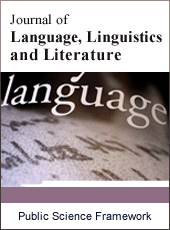Journal of Language, Linguistics and Literature
Articles Information
Journal of Language, Linguistics and Literature, Vol.1, No.4, Aug. 2015, Pub. Date: Jun. 10, 2015
Language Shift Among the Assyrians of Jordan: A Sociolinguistic Study
Pages: 101-111 Views: 7157 Downloads: 1428
[01]
Bader S. Dweik, Department of English, Faculty of Arts and Sciences, Middle East University, Amman, Jordan.
[02]
Tareq J. Al-Refa'i, Department of English, Scientific College of Design, Muscat, Oman.
This study aimed to investigate the sociolinguistic background of the Assyrians of Jordan. It also attempted to explore the domains of use of Syriac and Arabic. In order to achieve the objectives of the study, a purposive sample of 56 respondents, covering different age ranges, genders and educational backgrounds, was chosen to respond to the linguistic questionnaire. The instruments of the study were; an open-ended interviews and a sociolinguistic questionnaire. The overall analysis of the questionnaire and the interviews indicated that the Assyrians of Jordan were witnessing a shift from their ethnic language "Syriac" towards the majority language "Arabic". They consciously placed more importance on Arabic which enabled them to be assimilated in the mainstream society. The assimilation was driven by variety of factors such as seeking security in the society as a result of what they have witnessed in their original regions. Furthermore, the Assyrians of Jordan used Arabic in almost all domains. However results proved that Syriac was still minimally used in certain key domains such as at home with family members and at church. This shift was the result of historical, economic, demographic, linguistic and generational distance.
Language Shift, Assyrians, Jordan, Syriac, Arabic, Sociolinguistics
[01]
Al-Khatib, M. and Al-Ali, M. (2010).Language and cultural shift among the Kurds of Jordan. Sky Journal of Linguistics, 23(1), 7-36.
[02]
Dweik, B. & Al-Obaidi, T. (2014). Language contact language use and attitudes among the Chaldo- Assyrians of Baghdad, Iraq: A Sociolinguistic Study. Journal of Advances in Linguistics. 3(3), 219-231
[03]
Brobely, A. (2000). The process and factors of language shift and maintenance: A sociolinguistic research in the Romanians minority community in Hungary. Retrieved august 19 2012 from http://rss.archives.ceu.hu/archive/00001155/01/167.pdf
[04]
Chadwick, B., Bahr, H. & Albrecht, S. (1984). Social science research methods. Prentice-Hall: England.
[05]
Dashti, A.(2004). Language maintenance or shift? An ethnographic investigation of the use of Farsi among Kuwaiti Ajams. Arab Journal of Humanities. Retrieved July 27, 2010 from http://pubcouncil.kuniv.edu.kw
[06]
Dunlap, S. (1995). Nationalism, native language maintenance and the spread of English: A comparative study of the cases of Guam, the Philippines and Puerto Rico. (Unpublished Ph.D. dissertation) University of Puerto Rico: Puerto Rico. Retrieved February 13th 2013 from http://ponce.inter.edu/vl/tesis/sharon/diss.html
[07]
Dweik, B. (1986). Research papers in applied linguistics. Hebron: Hebron University Press.
[08]
Dweik, B. (2000). Linguistic and cultural maintenance among the Chechens of Jordan. Language, Cultural and Curriculum. 13. (2). 184-195.
[09]
Dweik, B. Nofal, M &Qawasmeh, R. (2014). Language use and language attitudes among the Muslim Arabs of Vancouver/ Canada: A sociolinguistic study. International Journal of Linguistics and Communication. 2 (2), 75-99.
[10]
Ferguson, C., Heath, S., & Hwang, D.(1981). Language in USA. New York: Cambridge University Press.
[11]
Fishman, J. (1966).Language loyalty in the United States. The Hague: Mouton and Co.
[12]
Fishman, J.(1972). the sociology of language. Rowley: Newbury House.
[13]
Fishman, J. (1989).The rise and fall of the ethnic revival: Perspectives on language and ethnicity. New York: Mouton.
[14]
Gabsi, Z. (2011). Attrition and maintenance of the Berber language in Tunisia. Int’l. J. Soc. Lang,211(1), 135–164.
[15]
Holmes, J (2001) an introduction to sociolinguistics, New York: Longman.
[16]
Jamai, A. (2008). Language use and maintenance among the Moroccan minority in Britain.(Unpublished Ph.D. dissertation). University of Salford: UK.
[17]
Kiraz, G. (2001). Assyrian or Syriac?: common language and heritage, different denominations. Retrieved on September 13, 2012 from http://www.midyatcity.com/articles/as-syr_kiraz.doc
[18]
Kondakov, A. (2011). Koch survey wordlists and sociolinguistic questionnaire. India: SIL International
[19]
Lucca, D., Masiero, G. and Gabriele(2008). Language socialisation and language shift in the 1b generation: A study of Moroccan adolescents in Italy. International Journal of Multilingualism, 5 (1),53-72.
[20]
Martin, N. (2009). Arab American Parents’ Attitudes toward their Children’s Heritage Language Maintenance and Language Practices. (M.A thesis). University of North Carolina at Chapel Hill: USA. Retrieved from https://cdr.lib.unc.edu/indexablecontent?id=uuid:15b293f9-982f-445f-9add-400e48ad38b4&ds=DATA_FILE
[21]
Milroy, J. and Milroy, L. (1978). Belfast: Change and variation in an urban vernacular. In P. Trudgill (Ed.). Sociolinguistic patterns in British English (pp. 19-36). London: Arnold.
[22]
Dweik, B &Nofal, M. (2014). Language maintenance among the Indians of Yemen: A sociolinguistic study. International Journal of Arabic English Studies. 13 (1), 89-112.
[23]
Odisho, E. (1999). Assyrian language maintenance and erosion in U.S: A World War immigrant family case study. Journal of Assyrian Academic Studies, 13 (1), 3-15.
[24]
Oshana, D. (2003). Cultural identification, Linguistic Competency, and Religious Participation as Mediating Constructs in the Development of Ego Identity among Assyrian American Adolescents.(Unpublished Ph.D. dissertation) .Loyola University: Chicago.
[25]
Sofu, H. (2009). Language shift or maintenance within three generations: Examples from three Turkish-Arabic speaking families. International Journal of Multilingualism, 6 (3), 246-257.
[26]
Tsitsipis, L. (2009). Language shift and Maintenance. Retrieved from http://www.eolss.net/Sample-Chapters/C04/E6-20B-09-02.pdf
[27]
Yildiz, E. (1999). The Assyrians: A historical and current reality. Journal of Assyrian Academic Studies, 13 (1), 15-30.
[28]
Yildiz, E. (2000). The Aramaic language and its classification. Journal of Assyrian Academic Studies, 14 (1), 23-44.
[29]
Younan, P. (2000). History of Aramaic. Retrieved from http://www.peshitta.org/initial/aramaic.html.

ISSN Print: 2381-7054
ISSN Online: 2381-7062
Current Issue:
Vol. 6, Issue 1, March Submit a Manuscript Join Editorial Board Join Reviewer Team
ISSN Online: 2381-7062
Current Issue:
Vol. 6, Issue 1, March Submit a Manuscript Join Editorial Board Join Reviewer Team
| About This Journal |
| All Issues |
| Open Access |
| Indexing |
| Payment Information |
| Author Guidelines |
| Review Process |
| Publication Ethics |
| Editorial Board |
| Peer Reviewers |


